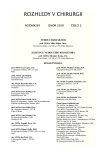Hemorrhagic Complications of Warfarin Therapy
Authors:
R. Kostka; L. Havlůj; D. Jirava; L. Novák; B. Vach; J. Weiss
Authors‘ workplace:
Chirurgická klinika 3. LF UK a FNKV Praha, přednosta: prof. MUDr. Robert Gürlich, CSc.
Published in:
Rozhl. Chir., 2010, roč. 89, č. 2, s. 124-129.
Category:
Monothematic special - Original
Overview
Introduction:
Introduction of warfarin use in prevention and treatment of thromboembolic diseases resulted in lower rates of thromboembolic complications, however, on the other hand, it has been associated with increased incidence of hemorrhagic complications, which often require surgical management.
Aim, Material, Methods: The aim of the study was a retrospective analysis of hemorrhagic complications in 184 patients, hospitalized in the FNKV (Královské Vinohrady Faculty Hospital) Surgical Clinic during 2000–2008, following warfarin overdose. The following diagnostic or treatment methods were used: endoscopy of the upper or lower GIT in GIT hemorrhages and spiral CT when peritoneal bleeding was suspected.
Results:
GIT bleeding, such as hematemesis, melena, enterorrhagy, was the commonest complication observed in 147 patients, ie. 79.9%. Upper GIT was identified as the source of bleeding in 76 subjects, i.e. 51.7%, lower GIT was the identified source in 26 subjects, ie. 17.7%, and the source remained unidentified in 45 patients, ie. in 30.6%. 10 patients suffered from soft tissue bleeding, m. rectus abdominis hematoma was detected in 7 subjects, hemoperitoneum and/or retrohemoperitoneum was identified in 8 subjects. Intestinal wall or its intestinal peritoneum was affected in 3 subjects and 3 patients suffered from liver or splenic intraparenchymal hematoma. Out of the total of 184 patients, 165 subjects were treated conservatively (89.7%), 19 subjects underwent surgery (10.3%), including 14 laparotomies for acute abdomen symptoms and 5 incisions with removal of hematomas. Overall lethality rate was 7/184, ie. 3.8%, 5 subjects undergoing conservative treatment and 2 subjects undergoing surgery exited.
Conclusion:
Uncontrolled warfarin administration may cause serious, even life - threatening complications. Therefore, patients undergoing warfarin therapy should be adequately informed about potential complications and regular INR monitoring is required.
Key words:
warfarin – hemorrhagic complications
Sources
1. Campbell, H. A., Roberts, W. L., Smith, W. K., Link, K. P. Studies of the hemorrhagic sweet clover disease. The preparation of hemorrhagic concentrates. J. Biol. Chem., 1940, roč. 136, s. 7–55.
2. Link, K. P. The anticoagulant from spoiled sweet clover hay. Harvey Lectures, 1943–1944, roč. 34, s. 162–207.
3. Schofield, F. W. Hemorrhagic sweet clover disease in cattle. Can. Vet. Rec., 1922, roč. 3, s. 74–75.
4. Quick, A. J., Stanley-Brown, M., Bancroft, F. W. A study of the coagulation defect in hemophilia and in jaundice. Am. J. Med. Sci., 1935, roč. 190, s. 501–511.
5. Link, K. P. The discovery of dicumarol and its sequels. Circulation, 1959, roč. 19, č. 1, s. 97–107.
6. Meyer, O., Bingham, J. B., Pohle, F. J. Read before the University of Wisconsin Medical Society, February 27, 1941.
7. Dam, H. Antihemorrhagic vitamin of the chick: occurrence and chemical nature. Nature, 1935, roč. 135, s. 652–653.
8. Stenflo, J., Fernlund, P., Egan, W., Roepstorft, P. Vitamin K dependent modifications of glutamic acid residues in prothrombin. Proc. Natl. Acad. Sci. USA, 1974, roč. 71, č. 7, s. 2730–2733.
9. Whitlon, D. S., Sadowski, J. A., Suttie, J. W. Mechanism of coumarin action: significance of vitamin K epoxide reductase inhibition. Biochemistry, 1978, roč. 17, č. 8, s. 1371–1377.
10. Bell, R. G. Metabolism of vitamin K and prothrombin synthesis: anticoagulants and the vitamin K-epoxide cycle. Fed. Proc., 1978, roč. 37, č. 12, s. 2599–2604.
11. Thomopoulos, K. C., Mimidis, K. P., Theocharis, G. J., Gatopoulou, A. G., Kartalis, G. N., Nikolopoulou, V. N. Acute upper gastrointestinal bleeding in patients on long-term oral anticoagulation therapy: endoscopic findings, clinical management and outcome. World. J. Gastroenterol., 2005, roč. 11, č. 9, s. 1365–1368.
12. Cheng, J., Vemula, N., Gendler, S. Small bowel obstruction cause by intramural hemorrhagie secondary to anticoagulant therapy. Acta Gastroenterol. Belg., 2008, roč. 71, č. 3, s. 342–344.
13. Sirvain, S., Crepeau, T., Garrido, J. F., Watteau, N., Niang, B., Hallé, O. Anticoagulant induced intramural duodenal hematoma presenting as duodenal obstruction. Gastroenterol. Clin. Biol., 2008, roč. 32, č. 6–7, s. 611–613.
14. Farhoud, S., Stephani, S. M., Bromberg, S. H. Acute pancreatitis due to intramural hematoma of the duodenum by the use of anticoagulants. Arq. Gastroenterol., 2001, roč. 38, č. 1, s. 53–56.
15. Procházka, V., Válek, V., Krejcí, I. Spontánní intramurální hematom duodenojejunálního přechodu zaměněný za akutní pankreatitidu. Rozhl. Chir., 2006, roč. 85, č. 12, s. 646–650.
16. Ivascu, F. A., Janczyk, R. J., Bair, H. A., Bendick, P. J., Howells, G. A. Spontaneous retroperitoneal hemorrhage. Am. J. Surg., 2005, roč. 189, č. 3, s. 345–347.
17. Subramanian, S., Gounder, S. M., Thirunarayanan, A., Kannan, A., Venu, N. Retroperitoneal hemorrhagic shock in a patient on warfarin therapy. J. Emerg. Trauma Shock., 2009, roč. 2, č. 2, s. 137–138.
16. Gumulec, J., Kessler, P., Procházka, V., Brejcha, M., Penka, M., Zänger, M., Machytka, E., Klement, P. Krvácivé komplikace antikoagulační léčby. Vnitřní lékařství, 2009, roč. 55, č. 3, s. 277–289.
Labels
Surgery Orthopaedics Trauma surgeryArticle was published in
Perspectives in Surgery

2010 Issue 2
Most read in this issue
- Osteoplastic Decompressive Craniotomy – Indication and Surgical Technique
- Complications in Patients Undergoing Pulmonary Oncological Surgery
- PCCP – First Choice of the Treatment of Trochanteric Fractures in our Orthopaedic Department
- Type II Bile Duct Cyst or Accessory Gall Bladder?
